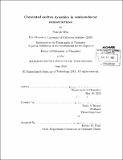| dc.contributor.advisor | Keith A. Nelson. | en_US |
| dc.contributor.author | Wen, Patrick, Ph. D. Massachusetts Institute of Technology | en_US |
| dc.contributor.other | Massachusetts Institute of Technology. Department of Chemistry. | en_US |
| dc.date.accessioned | 2013-11-18T19:09:00Z | |
| dc.date.available | 2013-11-18T19:09:00Z | |
| dc.date.copyright | 2013 | en_US |
| dc.date.issued | 2013 | en_US |
| dc.identifier.uri | http://hdl.handle.net/1721.1/82325 | |
| dc.description | Thesis (Ph. D.)--Massachusetts Institute of Technology, Dept. of Chemistry, 2013. | en_US |
| dc.description | Cataloged from PDF version of thesis. | en_US |
| dc.description | Includes bibliographical references (p. 211-223). | en_US |
| dc.description.abstract | The absorption and dissipation of energy in semiconductor nanostructures are often determined by excited electron dynamics. In semiconductors, one fundamentally important electronic state is an exciton, an excited electron bound to a positively charged vacancy. Excitons can become correlated with other excitons, mutually influencing one another and exhibiting collective properties. The focus of this dissertation concerns the origins, effects, and control of correlated excitons in semiconductor nanostructures. Correlated Coulomb interactions can occur between excitons, resulting in energy shifts and dephasing in each exciton. Two-dimensional Fourier-transform optical spectroscopy is a powerful tool to understand Coulomb correlations; the technique relates exciton dynamics during distinct time periods. However, the technique is still limited by weak spectral features. Using two-dimensional pulse shaping methods, waveforms of excitation fields were tailored to selectively amplify spectral features of correlated exciton states in gallium arsenide quantum wells. With the aid of theoretical models, 2D spectra of quantum wells revealed clear contributions of Coulomb correlations to the exciton dynamics. Time and power dependent properties of the 2D spectra indicate several mechanisms for exciton interactions that are neglected in commonly used theoretical models. If a semiconductor material is fabricated within a microcavity, optical fields can be trapped around the semiconductor, strongly distorting properties of the semiconductor excitons and forming new quasi-particles called exciton-polaritons. Theoretical work has suggested exciton-polariton Coulomb correlation strengths can be reduced compared to that of excitons. Using two-dimensional Fourier-transform optical spectroscopy, control of Coulomb correlations was demonstrated by varying the cavity structure. The cavity fields were also shown to induce high-order correlated interactions among exciton-polaritons. A macroscopic quantum degenerate system of exciton-polaritons can also become correlated, exhibiting long-range order typical of a Bose-Einstein condensate. However, unlike a Bose-Einstein condensate, exciton-polartions are not typically in thermal equilibrium. Using a sample with exciton-polariton lifetimes longer than previous samples, the macroscopic behavior of exciton-polaritons was investigated by imaging the exciton-polariton photoluminescence. Condensation depended significantly on spatially-varying potential energy surfaces. Using optically-induced harmonic potential barriers, thermal equilibrium among exciton-polaritons was achieved, with exciton-polaritons forming a Bose-Einstein distribution at densities above and below the condensation phase transition. | en_US |
| dc.description.statementofresponsibility | by Patrick Wen. | en_US |
| dc.format.extent | 223 p. | en_US |
| dc.language.iso | eng | en_US |
| dc.publisher | Massachusetts Institute of Technology | en_US |
| dc.rights | M.I.T. theses are protected by
copyright. They may be viewed from this source for any purpose, but
reproduction or distribution in any format is prohibited without written
permission. See provided URL for inquiries about permission. | en_US |
| dc.rights.uri | http://dspace.mit.edu/handle/1721.1/7582 | en_US |
| dc.subject | Chemistry. | en_US |
| dc.title | Correlated exciton dynamics in semiconductor nanostructures | en_US |
| dc.type | Thesis | en_US |
| dc.description.degree | Ph.D. | en_US |
| dc.contributor.department | Massachusetts Institute of Technology. Department of Chemistry | |
| dc.identifier.oclc | 861617989 | en_US |
